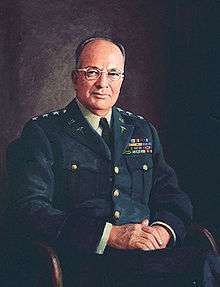Leonard D. Heaton
| Leonard Dudley Heaton | |
|---|---|
 | |
| Born |
November 19, 1902 Parkersburg, West Virginia |
| Died |
September 10, 1983 (aged 80) Washington, D.C. |
| Allegiance |
|
| Service/branch |
|
| Years of service | 1927–1969 |
| Rank |
|
| Commands held | Surgeon General of the US Army |
| Battles/wars |
World War II Cold War |
| Awards |
Distinguished Service Medal (3) Legion of Merit (3) |
Leonard Dudley Heaton (November 19, 1902 – September 10, 1983) was Surgeon General of the United States Army from 1959 to 1969.
Biography
Youth and education
Heaton was born in Parkersburg, West Virginia. As an undergraduate he attended Denison University in Granville, Ohio graduating in 1922. He then attended the University of Louisville where he would earn his medical degree four years later.
Service years
Heaton was commissioned as a first lieutenant in the Medical Corps Reserve immediately following his graduation from medical school. In 1940 he was assigned as Chief of Surgical Service in Hawaii. He was among the attending surgeons in the aftermath of the attack on attack on Pearl Harbor, where he operated and treated the wounded for over 24 hours straight. With the entrance of the United States into World War II, Heaton was assigned to the European Theater of Operations. Soon after D-Day, he was appointed as the Commander of the 802d Hospital Center in Blandford, England where he had over 12,000 people working under him.
After the war, Heaton was promoted to Brigadier General in 1948. He held many posts including being the commander of the Walter Reed General Hospital in Washington, DC. He became the tenth officer to command the hospital.
General Heaton was made Surgeon General of the Army in June 1959, and was promoted to Lieutenant General (three stars) in September, 1959. He was the first Army medical officer to attain this rank, and served a longer term as Surgeon General than any other officer since 1931. Aside from administrative duties, Heaton continued to surgically operate. Among his many patients included President Dwight D. Eisenhower, Secretary of State John Foster Dulles, and Generals of the Army Douglas MacArthur, and George C. Marshall.
As surgeon general, he oversaw the expansion and deployment of Army medical services to Southeast Asia and advocated for the increased use of helicopters for medical evacuation operations in the Army. He retired from the Army in 1969 and died at his beloved Walter Reed in 1983.
External links
| Military offices | ||
|---|---|---|
| Preceded by Silas B. Hays |
Surgeon General of the US Army 1959 – 1969 |
Succeeded by Hal B. Jennings |